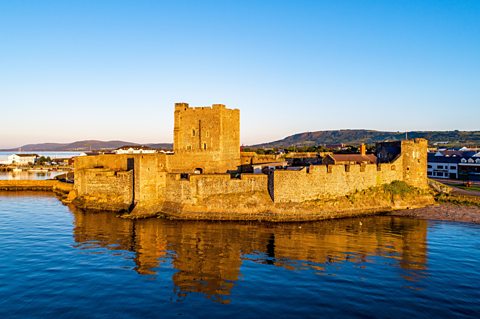Key points
- Harold Godwinson had defeated Harold Hardrada at the Battle of Stamford Bridge on 25 September 1066. For more on the claimants to the throne in 1066, read this guide.
- Three days later, William of Normandy invaded England, seeking to claim the throne.
- William and Harold fought at the Battle of Hastings on 14 October.
- William was victorious and was crowned King of England on Christmas Day, 1066.
Video about the Battle of Hastings
Watch this video to learn about the Battle of Hastings in 1066
Narrator: At dawn on the morning of 14th October 1066, William, his papal banner raised, and wearing the very relics round his neck which he claimed Harold had sworn on, marched his army just over 10 kilometres to confront Harold. The details of exactly what was to follow, and where it took place, vary considerably. But we do know that at about 9am, the battle for the English Crown began. The English were assembled on the crest of a small hill, flanked by two streams with woods behind, to make it difficult to retreat. Here they created a strong shield wall with Harold at the centre. The Normans were drawn up in three lines below.
The English and the Normans’ armour was very similar. Both sides wore conical-shaped iron helmets with a nasal, a metal strip which covered the nose to protect part of the face. Men of rank also wore the mail coat made of iron rings. It offered both protection and manoeuvrability, but was heavy.
But while the English had the Dane axe and used a defensive shield wall tactic, the Normans had 2,000 cavalry, which English battlefields had not witnessed before on this scale. They also had a huge line of archers. Some of these apparently used crossbows. Unknown to the English, these powerful mechanical weapons required less strength and training than the ordinary bow and arrow.
The Norman archers attacked first, but the distance was great, and their arrows mostly rebounded or flew above the Anglo-Saxons’ heads. It was then the turn of the mounted Norman knights, but the horses found it almost impossible to charge up the steep slope. Eventually the English shield wall pushed forwards. This forced the Normans back down the hill, and a rumour began to spread that William had been killed. But the story goes that William lifted up his helmet, and called out that he was alive, and with God’s help would win!
Then he decided to try an old Norman tactic, the feigned retreat. The Normans could not win the battle unless they broke the English line, which was packed so tightly it was said the dead were unable to fall. But if groups of cavalry pretended to flee, the English would believe they had won and chase after them. The cavalry could then quickly swing round, charge back and encircle the English pursuers, breaking the English shield wall.
The wall began to weaken. And as dusk drew in, William ordered his archers to attack once more. The English wall opened, and Harold was finally killed. The Bayeux Tapestry illustrates him being shot in the eye or cut down, but no one knows if this is what really happened.
The Normans had won. The last Anglo-Saxon king of England was dead, William had become the Conqueror and now he set off to London to claim the English throne.
Background to the Battle of Hastings
Following the death of Edward the Confessor, William, the Duke of Normandy, was angry when Harold Godwinson was crowned King of England in January 1066.
William planned to Invade in August, but poor weather conditions meant he had to wait until September. He carried with him the papal bannerA flag that represents the Pope, the head of the Catholic church., meaning he had the support of the Pope, the leader of the Catholic Church.
William landed on the south coast of England with his army while Harold Godwinson was on his way back from the north, where he had defeated Harald Hardrada’s invasion at Stamford Bridge. William and his army headed to Hastings via London, collecting extra troops on the way. In contrast to Harold Godwinson’s army, William and his men were well-rested and prepared for battle. The two sides lined up against each other at Senlac Hill, seven miles outside of Hastings, on 14 October 1066.
Claimants to the throne activity
Learn more about the claimants to the throne in 1066 with this activity.
Who fought in the Battle of Hastings?
The two sides:
| Harold Godwinson’s army | William’s Norman army | |
|---|---|---|
| Types of soldiers | Harold’s army was largely made up of the fyrdPart-time soldiers who were called up to fight when needed. and housecarlsProfessional soldiers, who were well-trained and armed.. | William had a range of soldiers available to him: cavalrySoldiers on horseback., archersSoldiers trained to shoot a bow and arrow. and foot soldiersSoldiers who fight without a horse, so fight on their feet.. |
| Fighting experience | Harold’s army had a mix of fighting experience. The fyrd were part-time soldiers who were called up to fight when needed. They had little training and were not well armed, often using farming tools for weapons. The housecarls were well-trained, professional soldiers. | It is believed that William’s army had more fighting experience overall. |
| Size | It is believed Harold had between 7,000 and 8,000 soldiers at Hastings. | Most historians think William’s army was also between 7,000 and 8,000 soldiers. |
| Energy | Harold’s army were tired from just defeating Harald Hardrada at Stamford Bridge. | William’s army were well-rested and ready for battle. |
Who do you think had the stronger army? Harold or William?
William had the stronger army. His men were well-rested, better trained, and generally had more experience in battle. He also had a wider range of soldiers available, with archers and cavalry.
What happened at the Battle of Hastings?
The events of the battle
- The Battle of Hastings began at 9am on 14 October 1066. Harold’s army was lined up at the top of Senlac Hill, forming a shield wall facing down against William’s army. At the start of the battle, William’s archers fired their arrows up towards Harold’s army but were struggling to break through the shield wall.
- William’s cavalry then tried to charge up the hill, but they also could not break past the defensive line and were beaten back by Harold’s men.
- A rumour spread through the Norman army that William had been killed, but he lifted his helmet and rode past his troops to show them he was still alive.
- Harold’s position was looking strong, but William ordered his soldiers to advance part way up the hill and then pretend to retreat. This was hugely effective. Harold’s army lost their discipline and started charging down the hill, losing their strong defensive position. William’s cavalry were able to get amongst the English army and cause huge damage, as Harold’s army had lost the protection of the shield wall and their defensive position at the top of the hill.
- There is some uncertainty as to how Harold Godwinson died. The Bayeux TapestryThe Bayeux Tapestry is an embroidered cloth showing the events before, during, and after the Battle of Hastings. It shows William as the rightful heir. Historians need to be aware that it was produced by the Normans when using it as a source of evidence. has the words 'Harold is killed' next to a man with an arrow in his eye, but it is impossible to know which soldier is Harold because all of the English soldiers are dressed identically.
- Harold’s remaining soldiers lost motivation when news of his death spread across the battlefield. Some fled, and the ones who stayed to fight were left with little hope.
Activity - Put these events into the correct order
Why did William win?
- Tiredness: Harold’s army had to march north to fight Harald Hardrada at Stamford Bridge, before turning back to march to the south to face William at Hastings. Many of the English army had been killed and the those who were left would have been extremely tired.
- Tactics: William’s army pretended to retreat, tempting Harold’s army into losing their strong defensive position to run after them. William’s army was then able to turn round and attack Harold’s weakened position.
- Army strength: William had a greater range of soldiers for the battle. As well as foot soldiers, he had a cavalry and more skilled archers. This gave his side a big advantage in the range of tactics and attacks they could carry out.
- Leadership: William was on horseback and had an overview of the whole battlefield. When a rumour went round his army that he had been killed, he lifted his helmet to show them he was still alive. In contrast, Harold was on foot and was unable to stop his army losing their discipline and chasing down Senlac Hill after William’s retreating soldiers.
Could Harold have done anything differently to win?
Some historians have argued that Harold could have waited longer before advancing to Hastings to fight William. This would have given his tired army longer to rest and also gather more soldiers.
A key turning point in the battle itself was when the fyrd started chasing William’s army down the hill. If they had maintained their strong position at the stop of Senlac Hill, along with the strong shield wall, it is possible the battle could have turned out differently.
What happened after the Battle of Hastings?
Winning the Battle of Hastings was only the beginning of the Norman Conquest. It was a turbulent time for England, with three kings in one year. After William won the Battle of Hastings, his army had to capture and subdue towns across the southeast. The Normans were not welcomed with open arms, suggesting that many English people were not happy about the change in leadership.
William seized Dover and Winchester, before advancing to London. He was crowned on Christmas Day, becoming England’s third king in 1066. He went on to make many changes to secure his control of England. Many of these changes had long lasting effects, for example land ownership, the building of castles, and the introduction of some Norman laws.
The Bayeux Tapestry
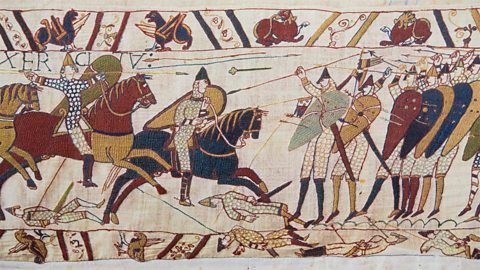
The Bayeux Tapestry was produced by the Normans following William’s conquest. Its origins are not known for certain, but some historians believe it was arranged by William’s half-brother, Odo, and sewn by English women.
The tapestry is 70 metres long and gives an account of events from 1064 - 1066. Although the tapestry was made almost 1,000 years ago, historians still debate about who made it, why it was created and how it presents the events of 1064 - 1066.
How is Harold presented in the Bayeux Tapestry?
It could be assumed that because Harold was defeated at the Battle of Hastings, he would be presented negatively by the victorious Normans in the Bayeux Tapestry. Instead, the tapestry is surprisingly kind towards Harold, showing him as a good fighter and worthy opponent.
Historians believe the Normans organised the making of the tapestry, but it doesn’t overtly celebrate their victory. Historians have suggested this is because the Normans didn’t want to anger the English people they were now ruling over.
Test your knowledge
Teaching resources
Looking for something extra to help bring your history lessons to life? This animated series tells the story of how William The Conquerer successfully conquered England in 1066 and became the first Norman King of England.
Â鶹Éç Teach has thousands of free, curriculum-linked resources to help deliver lessons - all arranged by subject and age group.
Play the History Detectives game! gamePlay the History Detectives game!
Analyse and evaluate evidence to uncover some of history’s burning questions in this game.

More on The Normans
Find out more by working through a topic
- count3 of 6
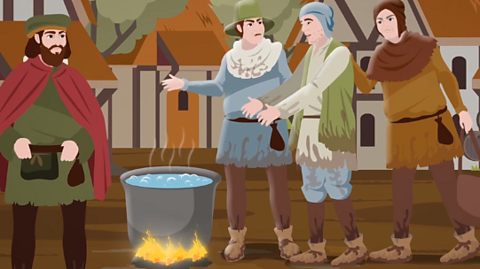
- count4 of 6
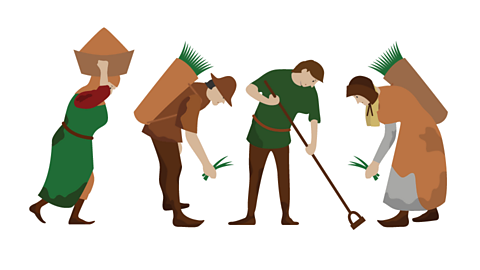
- count5 of 6
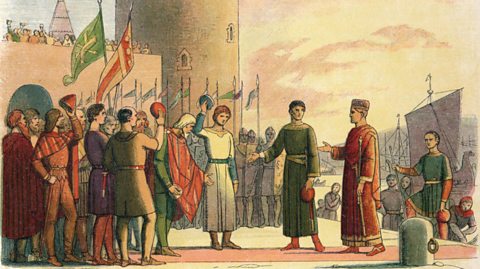
- count6 of 6
